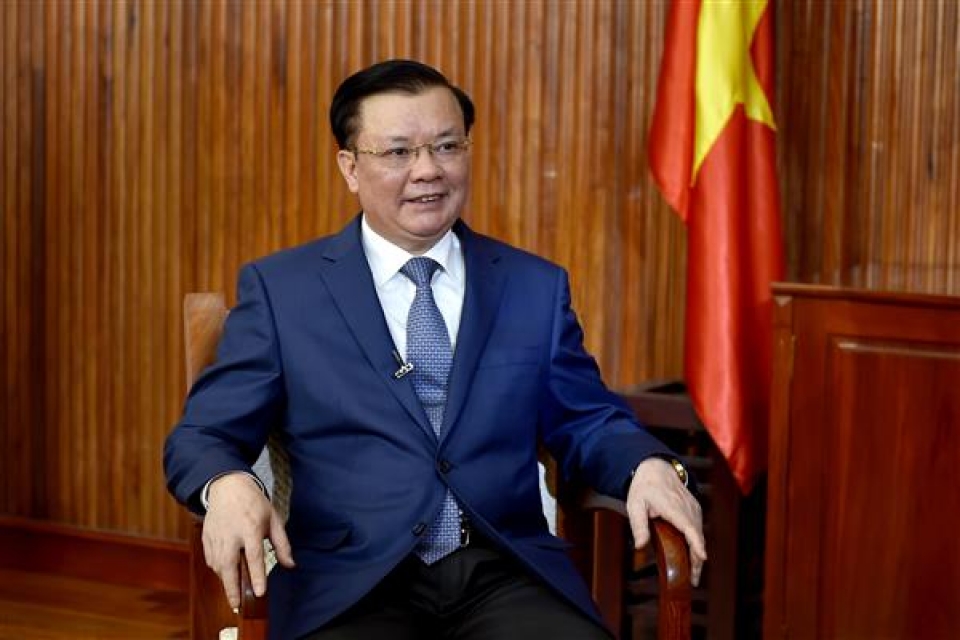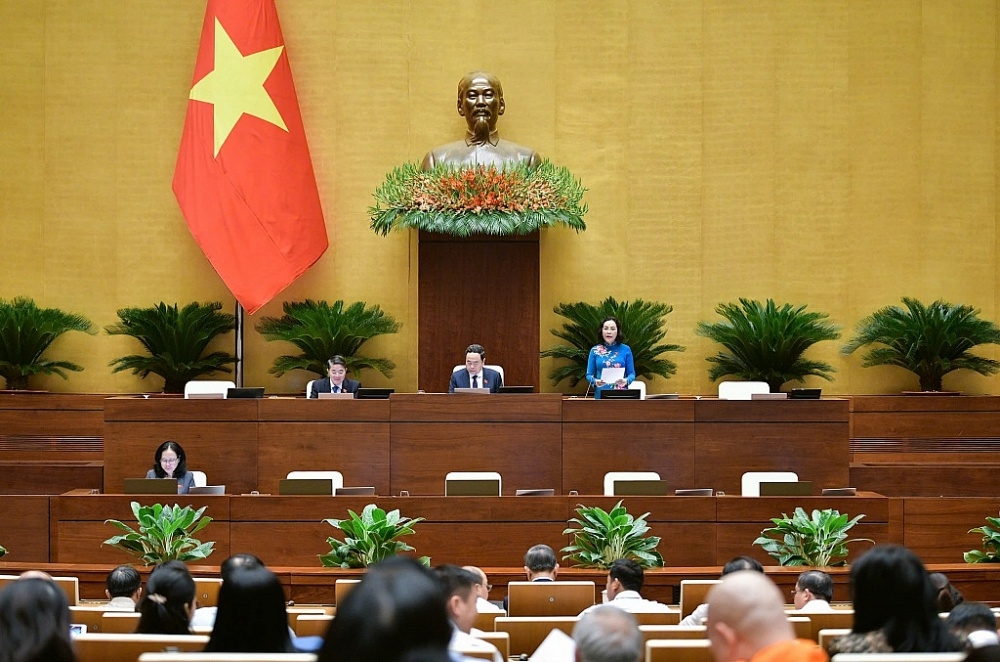Minister Dinh Tien Dung: The Financial sector to build a streamlined and efficient administration apparatus
 |
| Minister of Finance Dinh Tien Dung |
Recently, the Ministry of Finance has always been considered as one of the leading units in reforming institutions and policies, creating favorable conditions for production and business activities of people and enterprises. Could you please share some outstanding results of this work?
Over the past time, the institutional reform of the Ministry of Finance has always been associated with the development and finalization of financial law system. Thereby, the financial law system has been improved with a large number of legal documents that have been amended, supplemented and issued.
With many creative ways such as one law amends many laws, one decree amends many decrees and one circular amends many circulars, many documents have had a strong impact, removing difficulties for production, improving business environment and creating legal basis to simplify administrative procedures, reduce business conditions and modernize management. As a result, step by step changing the management method from pre-inspection into post inspection (which has increased the pressure on the management agencies but facilitated the people and businesses), as well as making information and procedures transparent for implementation.
In the 2011-2015 period, the Ministry of Finance submitted to the National Assembly 14 bills, 4 National Assembly’s resolutions, 3 National Assembly Standing Committee’s resolutions and proposed the Government and the Prime Minister to promulgate 99 decrees, 109 decisions and promulgated under its competence 1,104 circulars and joint circulars.
From 2016 up to now (as of October 2nd, 2018), the Ministry of Finance has submitted to the National Assembly 4 bills, 3 National Assembly’s resolutions, 5 National Assembly Standing Committee’s resolutions and proposed the Government to issue 111 decrees, 28 decisions and promulgated under its competence 551 circulars.
The Ministry of Finance promptly instructed the units to strictly implement the requirements of administrative procedure reform such as linking the administrative procedure reform and reduction of business conditions with the institutional reform; strictly controlling the issuance of new administrative procedures according to law provisions right at the drafting stage; actively reviewing, cutting and improving the quality of administrative procedures in the financial field, especially administrative procedures related to people and enterprises; publicizing all administrative procedures.
As a result, in the 2011-2015 period, 248 administrative procedures were cut and 962 were simplified. At the end of 2015, the administrative procedures were 1,045 procedures, in which the procedures in the tax field were 395, in the Customs field were 219, in the securities field were 161 and in other financial fields were 213.
From 2016 until now (as of October 2nd, 2018), 174 administrative procedures were reviewed and cut and 888 were simplified. As of October 2018, 2018, the administrative procedures in the financial sector were 987, including 298 administrative procedures in the tax field, 183 in the Customs field, 184 in the securities field, 22 in the State Treasury field and 300 in other financial fields.
In order to continue administration reform with the key being the control of administrative procedures, the Ministry of Finance has guided the review, simplification and removal of unnecessary and cumbersome administrative procedures. At present, the specialized units of the Ministry of Finance have developed the plan and are submitting to the Ministry's leaders for approval to cut over 140 administrative procedures and simplify 28. At the same time, the Ministry of Finance is submitting to the Government a draft decree amending and supplementing a number of decrees on investment and business conditions under the State management scope of the Ministry of Finance, which is expected to reduce 117 business conditions.
Reform is the "flag" of the whole Government, but not all ministries can be drastically implemented and gain measurable results in quantity and quality. In your opinion, what is the reason for the Ministry of Finance to carry out such vigorous reform?
Thanks to the unified direction and guidance in all financial fields, not only the results in each field, but the financial fields have supported each other and created an effect to improve the efficiency of administrative procedure reform for the whole sector. The administrative procedure reform and the reduction of business conditions have been implemented drastically, many administrative procedures have been cut, simplified and the processing time and compliance costs have been reduced. Thereby, creating favorable conditions for people and enterprises, contributing to improving the business environment, enhancing national competitiveness, improving the tax payment indicators and cross-border trade ranking.
Together with that, the organizational structure of the Ministry of Finance was renovated, rearranged to meet the management requirements. The contingent of cadres and civil servants with capacity and basic qualifications has been increasingly improved to meet the requirements of task performance. Public finance has been reformed on the mobilization, allocation and use of financial resources and financial security has been ensured. Modernization of the finance sector has been focused, the equipment has been invested, updated and modernized to apply information and technology, meeting the requirements on innovation and modernization in the handling of administrative procedures and the management.
The reform results of the Ministry of Finance have contributed positively to improving the business environment, enhancing national competitiveness, and have been highly appreciated by the society, people and enterprises. The results have been expressed in assessment indexes, such as the Ministry of Finance was always in the group of 3/19 ministries, ministerial-level public administration reform index (Par index) in the past four years (from 2014 to 2017) and topped in the ICT readiness index for six consecutive years (from 2013 to 2018).
Not only reforming administration and modernizing the operation to support people and enterprises, the Ministry of Finance has also actively deployed the apparatus streamlining. What are the results of this work, Minister?
In the implementation of the Party’s solutions, the Financial sector attached a great importance to staffing streamlining and apparatus restructuring in streamlined and efficient manner.
The Ministry of Finance is a multi-sectoral management ministry. Under the provisions of the Government's Decree No. 87/2017 / ND-CP on the functions, tasks, powers and organizational structure of the Ministry of Finance, apart from 20 professional departments and 9 non-business units, Ministry of Finance has also 5 general departments and subordinate units (of which 4 general departments are organized vertically from central to local levels), 183 local departments, more than 1,700 branches and equivalent units and more than 5,700 divisions under branch level and equivalent level.
Implementing Conclusion No. 64-KL / TW dated May 28th, 2013 of the Party Central Committee's 7th plenum (Term XI), the leaders of the Ministry of Finance paid attention to directing and guiding the implementation of some solutions to renovate and arrange the organizational structure of the Financial sector towards streamlining and efficiency. Accordingly, from early 2013 to October 2018, the Ministry of Finance has cut about 3,000 units from the central level to the local team level (in which reducing 180 units at division level and equivalent level; 2,800 units at local division level. The number of public non-business units under and attached to the Ministry of Finance has decreased from 35 units (end of 2016) to 28 units due to reorganization, dissolution and suspension.
Implementing the Resolution Party Central Committee's 6th plenum(Term XII), , the Ministry of Finance has strengthened and arranged its units in a streamlined manner, multi-sectoral management, in immediate reduction and in the principle that one task is only assigned to one unit. Accordingly, the Ministry of Finance has reduced 53 branches and equivalent units in local departments, in which dissolving one customs branch, merging 10 state reserve branches into 5 branches, dissolving 43 transaction divisions under provincial State Treasuries, merging 7 tax branches into 3 regional tax branches; cutting 357 teams and equivalent units at branch level in local departments; continuing to rearrange and merge tax branches to organize the regional operation, ensuring that by 2020, there will be 420 tax offices; reorganizing units at division level in local tax departments according to the provisions of Decision No. 41/2018 / QD-TTg of the Prime Minister.
In order to merge tax branches by region in the whole system, the Ministry of Finance has merged 7 district tax branches into three regional tax branches under Quang Ninh Tax Department, consolidating the apparatus, reducing 4 tax branches and 19 tax teams. In October 2018, continuing to merge tax branches in provinces Hai Duong, Yen Bai, Quang Ngai, Lam Dong and Ca Mau.
In the coming time, continuing to implement the Government's Resolution No. 08 / NQ-CP of January 24th, 2018, on the Government's action program for the implementation of Resolution No. 19-NQ / TW, including the task of developing the Project on restructuring of training establishments of the Ministry of Finance in the direction of merging 5 training establishments under the General Department into the Institute of Financial Training under the Ministry of Finance. In the immediate future, from 2018 to 2020, the merger will be carried out for 2 to 3 units and by 2021, the merger will be continued for remaining units.
 | Budget deficit will continue to fall in 2019 VCN - On October 22, 2018, authorized by the Prime Minister, Minister of Finance Dinh Tien Dung ... |
To meet the requirements of the Party, State, Government and people as well as integration requirements, the Financial sector still faces many challenges and difficulties. What solutions have been carried out to continue the reform in the coming time, Minister?
In the coming time, the Ministry of Finance will continue to accelerate the administration reform and administrative procedure reform to meet the integration requirements, strive for the PAR index in the ranking of 4 ASEAN countries and towards standards of OECD countries. In particular, focusing on a number of solutions, such as: strengthening the direction, raising the responsibility of the head; promoting the creativeness and raising the quality of the elaboration of legal documents; reforming administrative procedures and considering people and enterprises as the center; building a streamlined, effective and efficient administration apparatus; building the contingent of cadres, civil servants and public employees in the financial sectors, who are quantitatively sufficient, professionally qualified and capable to perform public duties; reforming public finance towards mobilizing and using effectively all resources to contribute to financial security; taking the initiative in the deployment and application of information technology to meet the requirements of the industrial revolution 4.0.
Thank you, Minister
Related News

Quang Ninh Customs: Innovation in developing Customs-Business partnership
09:27 | 29/10/2024 Customs

Businesses can choose a suitable electronic invoice model generated from the cash register
14:18 | 25/10/2024 Finance

Rush to finalize draft decree on public asset restructuring
09:28 | 29/10/2024 Finance

Ministry of Finance proposes to choose the option of reducing land rent by 30% in 2024
15:29 | 20/10/2024 Regulations
Latest News

M&A activities show signs of recovery
13:28 | 04/11/2024 Finance

Fiscal policy needs to return to normal state in new period
09:54 | 04/11/2024 Finance

Ensuring national public debt safety in 2024
17:33 | 03/11/2024 Finance

Removing many bottlenecks in regular spending to purchase assets and equipment
07:14 | 03/11/2024 Finance
More News

Continue to handle cross-ownership in banks
10:35 | 02/11/2024 Finance

Striving for average CPI not to exceed 4%
16:41 | 01/11/2024 Finance

Delegating the power to the government to waive, lower, or manage late tax penalties is suitable
16:39 | 01/11/2024 Finance

Removing difficulties in public investment disbursement
09:30 | 31/10/2024 Finance

State-owned commercial banking sector performs optimistic growth, but more capital in need
09:28 | 31/10/2024 Finance

Stipulate implementation of centralized bilateral payments of the State Treasury at banks
09:29 | 29/10/2024 Finance

Inspection report on gold trading activities being complied: SBV
14:37 | 28/10/2024 Finance

Budget revenue in 2024 is estimated to exceed the estimate by 10.1%
10:45 | 28/10/2024 Finance

Ensure timely and effective management and use of public asset
11:31 | 27/10/2024 Finance
Your care

M&A activities show signs of recovery
13:28 | 04/11/2024 Finance

Fiscal policy needs to return to normal state in new period
09:54 | 04/11/2024 Finance

Ensuring national public debt safety in 2024
17:33 | 03/11/2024 Finance

Removing many bottlenecks in regular spending to purchase assets and equipment
07:14 | 03/11/2024 Finance

Continue to handle cross-ownership in banks
10:35 | 02/11/2024 Finance




